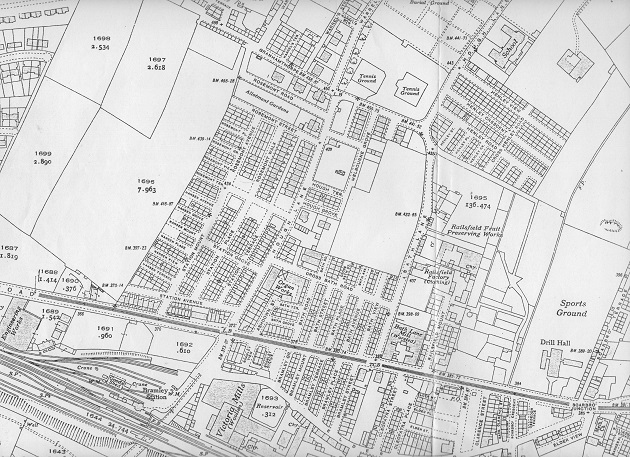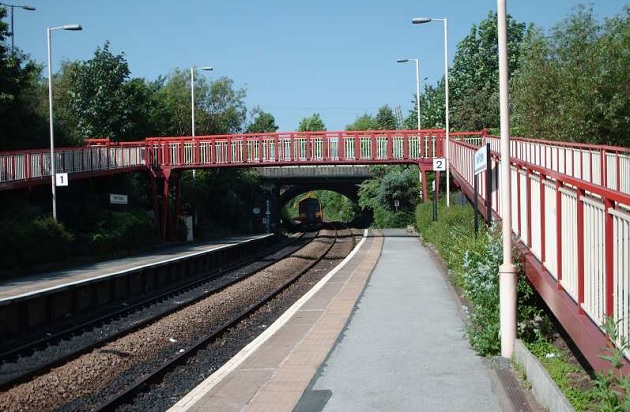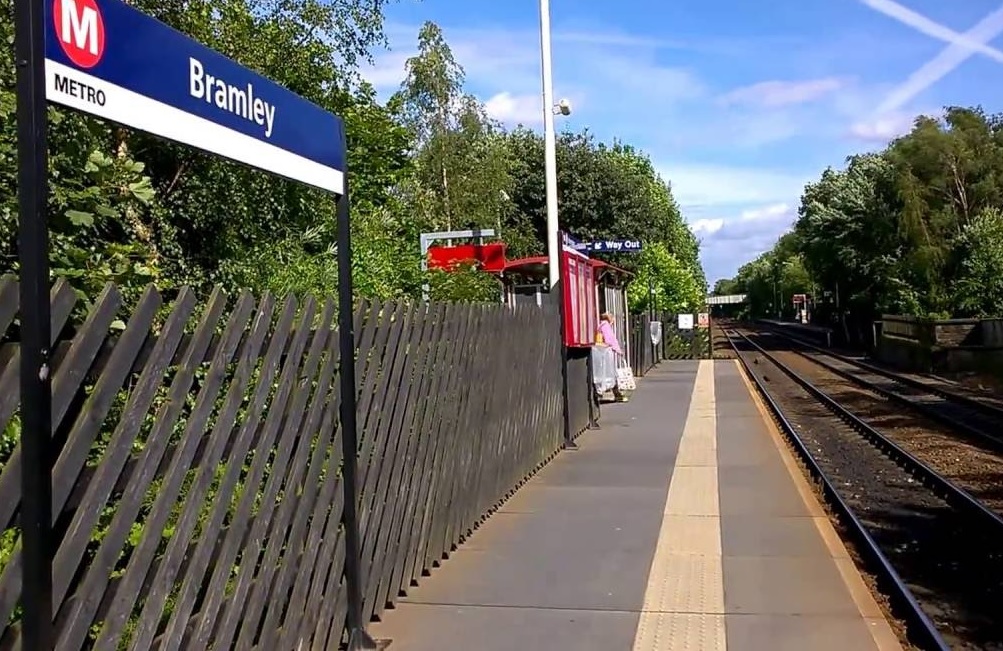Bramley began life as Bram’s Lea, a small settlement to the West of Leeds, and was included in the Domesday Book.
The history of the village is well-documented in other publications so I will concentrate on the railway, its coming, its prosperity, its demise and its resurrection.
The railway was first mooted in 1846 by businessmen who wanted better links from the West Riding to both coasts.
The wool merchants looked to the West and East for both supply and export and although the Calder Valley line already existed it was a long way round.
Eventually the Leeds Bradford and Halifax Junction Railway received permission from Parliament to construct the line.
The line was built from Leeds Wellington Station and after Holbeck station bore left at Wortley Junction and ran nearly parallel to Tong Road, before underpassing same just before Armley Moor Station.

Leaving Armley Moor it underpassed Whingate and followed the contours round Greenhill under Heights Lane and over Henconner Lane.
Now it bridges the Stanningley Bypass before going under Hough End Lane and Warrington’s Farm bridge and into Bramley Station, bridging Swinnow Road.
On over Swinnow Lane through a cutting into Stanningley and over the viaduct and onto Laisterdyke then Dudley Hill and Bowling Junction where it joined the lines of the Lancashire and Yorkshire Railway.
The line followed contours and used cuttings and embankments to keep the line as level as possible, Bramley station is half embankment, as can be seen from South of the station. The line from Leeds was a steady up gradient all the way to Laisterdyke, and on frequent occasions during the early life of the railway, engines used to run out of water.
The station was built on Gothic lines as were the stations at Armley and Stanningley pictures of which show a striking resemblance.
Level access was provided from the top of Swinnow Road just below its junction with Stanningley Road and this still remains the same with some alteration.
There was a large wooden gate that was locked when the station was closed as was the gate at the pedestrian entrance on Swinnow Road just above the bridge.
From the level area entry to the station proper was through a gate onto the UP platform upon which all the buildings to do with the running of the station were sited.
These consisted of, immediately to the right of the gate a large house type building which on the ground floor consisted of the waiting room and ticket office.
The waiting room was sparsely furnished with wooden benches along two walls, the other two walls consisted of the ticket office window and door, and the other housed a large fireplace in which the fire burned ceaselessly.
The upper floor provided living quarters for the station master though access to those were up a staircase to the rear of the building.
The rest of the buildings consisted of a Ladies waiting room, a tool store, gentlemen’s convenience and staff room. In order to reach the DOWN platform one had to cross by a footbridge that spanned the lines at the Eastern end of the platforms, the only building on this platform being a small shelter.

So it was on the 1st August 1854 the first train, presumably with all due pomp and ceremony, left Stanningley Station 30 minutes late (so setting the precedence for late running) and arrived in Leeds 50 minutes late, much to the consternation of the wool merchants aboard who were late for the market.
At the time of opening there were very little signs of habitation in the immediate area, save for a few dwellings on Back Lane (Elder Road later) and the top of Swinnow Road.
Industry comprised of the cottage workers around Town Street and Elmfield, Victoria, Priestley and Westfield Mills along with numerous quarries.
The railway contributed to the expansion of industry as other mills were built and as well as serving the traders it also carried passengers from as far as Pudsey and Farnley. The map of 1860 shows the sparsity of buildings in the area of the station.
Fast forward to 1893 and we see a remarkable change, the development of dwellings mushroom in the vicinity spreading North and East.

Bramley Station itself expanded with the construction of buildings to facilitate the movement of goods.
The railway goods wagons being designed to match the height of the carts being pulled by horses and the docks were built to the same level. (the width of the railway and the width of carts going back to Roman times).
A crane was installed, worked by a windlass, to aid the handling of heavy and bulky goods. Mills and other works began to flourish as entrepreneurs looked at siting their businesses in the area.
The map of 1893 shows the diversity that has been introduced into the area with worsted and woollen mills, boot and shoe, tanneries, organ works and fruit preserving amongst the industries.
Housing, consisting of mainly back-to-back with shared outside lavatories were built either side of Stanningley Road to the East of the station.
These being the Baths and the Bramleys and those that fronted onto Stanningley Road being built as shops which provided for the needs of the budding population.
Like most of the factories they have been demolished in the name of progress (covers a multitude of sins does progress) or as it was called slum clearance but they were good homes to many people.
The railway company, Leeds Bradford and Halifax Junction was taken over by the Lancashire and Yorkshire railway which in turn became part of the GNR and the line to Pudsey was established making a loop from Bramley to Tyersal/Laisterdyke.
The companies provided nearly seventy trains per day through Bramley offering passengers a great service.
Approximately half of those going round the loop to service the two Pudsey stations. The embankment was extended Southwards along with two new bridges to provide for doubling the track as the freight traffic grew.
Private sidings were also laid into Victoria Mills and to the Railway Foundry which would eventually become Turner Tanning Machines Ltd. Doubling of the track meant more trains were able to be accommodated therefore more freight traffic as well as keeping up the passenger flow.
The turn of the century brought competition to the railway in the form of the tramway which was laid along Stanningley Road and began providing a service to Stanningley and Leeds.
The tramway offered the passenger more flexibility and more accessibility to closer areas so some passenger traffic was inevitably lost. The journeys to the city were always going to be in favour of the train, by a good few minutes.
The passenger loss showed in the reduction of carriages from ten to five.
Whether it was the advent of the tramway system or the solvency of the railway the area prospered and building continued apace.
Station Parade, providing numerous shops to complement the corner shops of the Baths and Bramleys, was completed along with the Nansens and Stations extending Northwards towards the Rosemonts, Warrels and Henleys, giving the residents the option of shopping on Stanningley Road or Town Street.
There was virtually no development south of the station but this was soon to change as land to the North became less available.
Another factor in the equation was the movement of people out of the city as transport was easy, cheap and accessible. Bramley, especially in the area of the station, proved popular as it gave the choice of a quick journey into the city by train or a stop start journey with Leeds City transport and as Leeds city centre began to become more commercial so the transport systems flourished.
In the station area extra facilities were provided for in the shape of a water tower, this being possible with the construction of the reservoir at the top of Beecroft Hill by Leeds Corporation.
The goods area was enhanced to provide more flexibility with regard to the advancement of motor transport.
The coal depot was serviced by a number of companies as seen in advertisements in the Bramley Almanac, but eventually ended up in the hands of James Wood and Sons until the demise of the station and the enforcement of smokeless zones.
Some of the goods were carried in the guards van, items such as live chickens among others, which were deposited on the platform and left for the station lads to pick up and deliver to the consignee.
A good many excursions also left Bramley on Public Holidays taking people to the East and West coasts, Blackpool and Scarborough being just two of the popular destinations.
The Great War then intervened in any further developments and little local history is written about this time, most of it about those who went to war and never returned, some of whom worked at Bramley station.
After the war and the regrouping of the railways in 1923 little was altered except for the timetable, this due to the fact that fewer trains stopped at Bramley as passenger levels dropped, especially through the daytime.
Another factor may have been the improved service being offered by Leeds City transport and their trams.
The freight traffic more than held its own and probably increased as more factories and mills opened or increased production, most of them using the railway and Bramley Station to ensure delivery.
South of the station was home to a large area of Rhubarb growing which was covered with the forcing sheds.
Every January at picking time the railway would put on a train “The Rhubarb Special” to leave Bramley at 8.30pm every night bound for the market towns over the country, and especially Covent Garden.

By the middle thirties development South of the station had taken place, Tapp and Toothill were established below the station on Swinnow Road(Space now occupied by Morrisons) with Sunnyside Road opposite, the Park Springs and Swinnows were also built.
More development to the North included the building of Fairfield Estate by the council.(Originally named the Westfield the estate took its name from the street titles)
World War Two provided little chance for change except for increased freight due to the war effort. Thankfully the area did not suffer much bomb damage.
Bramley Station survived without a scratch, the nearest bomb falling about 200 yards away on Fairfield Street, but thinking has it that the intended target was Turners as they were involved in engineering work for the war.
One of their products at that time being the locking bulkhead doors for submarines,n a example of which can still be seen in the wall abutting Stanningley Road.
I moved with my parents and two brothers onto Sunnyside Road during the time of deep snow in 1947 and everything had to be carried from Swinnow Road to the house.
Recently my brother related one of his experiences of the time. He was out playing on his sledge when he noticed a wagon pass up Swinnow Road, upon its side were the words “Woods for Coal”.
Being a logical chap he went around scraping every bit of wood he could find then made his way up to the coal yard. He arrived at the door with a sledge full of wood and asked, politely of course, if he could have some coal as your wagon said wood for coal and we don’t have any.
It worked because a little later a sack of coal was delivered and the house was warm again. Being only a baby at the time I don’t know if payment was made but the story is a nice one.
As the years passed I spent many a happy hour on Bramley Station, sometimes getting underfoot but generally making myself useful. Remember the fire, it was still burning and I used to feed it coal when necessary.
I became a dab hand at making tea, collecting tickets, slamming carriage doors, helping in the ticket office (you had to watch your fingers in the ticket stamper) and occasionally ringing the bell to acknowledge the signalman in his box (under supervision of course).
The HSE would have a “hissy-fit” over anything like that nowadays, although I was never allowed in the goods yard.
Jean Parker was the station master who I and my parents got to know very well as my father used the station every day to travel to and from work and I used to go meet him with my mother and later by myself.
The most evocative memory of those days is of standing on the footbridge whilst the steam engine passed underneath, the smell of smoke and steam and the blast of hot air—–utter heaven to a young boy (and heaven to a lot of big boys today when they get the chance).
Sadly my father passed away, succumbing to the big ‘C’ and Bramley Station lost some of its magic for me.
The magic of the railways was also disappearing for others as buses began to monopolise public transport, better designs providing more comfort, larger more powerful engines and most importantly flexibility to meet the expanding demands of the community.
Unlike the trains and the trams, buses are not limited to tracks and so they were ideal to serve the new developments that sprung up on the outskirts of the city.
Debates began about the financial state of British Railways as the whole system was now called after Nationalisation. This being so because they were now accountable to the whole nation and not just the shareholders of the big four. (LMS, LNER, GWR, and SR).
Eventually the system came under the scrutiny of Dr. Beeching and his axe fell rightly or wrongly upon many lines and stations.
One presumes his arguments held with the politicians, as there was no doubt that the railways as a whole were haemorrhaging money at an alarming rate, and the fate of Bramley Station was sealed.
In one sense Bramley was luckier than a lot of other places in that the line remained between Leeds and Bradford and it was just the intermediate stations that suffered demise.
So it was in July 1966 Bramley Station closed its doors. The goods yard and coal yard survived for a few years but eventually the buildings were razed, the goods lines removed, the ground cleared and new fencing erected to protect the railway.
The powers-that-be then began building a station called New Pudsey, which became one of the first “park and ride” stations.

Leeds City Transport disappeared under local government reorganisation with the West Yorkshire Transport Authority being created, which in turn became the West Yorkshire Passenger Transport Executive.
This new body had the remit to report on the provision of public transport in West Yorkshire and in its wisdom decided that there was a need for another station or stations on the Leeds Bradford line.
Several sites were discussed but the only place deemed suitable was Bramley.
So history turned full circle and 129 years after the first train ran Bramley reopened, not as a station but more as a passenger halt.
Passenger traffic has increased significantly over the years (as many as 50 alighting at Bramley from one train in the peak hour) with both foot and park and ride passengers increasing.
Access to the UP platform remains the same as it used to be, through a gate from the level area but access to the DOWN platform is via a pathway to the South of the station below the still standing bridges. No ticket office means tickets are either pre-purchased or paid for on the train.
Not many expresses used the line but there was “The Devonian”, which ran from Bradford Exchange to Paignton in Devon up to the 1960’s. This train did call at Leeds City then used the old LMS line to Sheffield, Derby then across to Birmingham, Bristol and so to Devon.
The Intercity 125 ran every day for a few years from Bradford to Kings Cross, calling at Leeds, the driver swapped ends in Leeds.
Even less frequent were the main line engines or Pacifics as their weight restricted them over some of the local lines although I did once see a Gresley A4 pass through Bramley, a most uncommon occurrence.
Article copyright D Angood. 22/06/2014



Thank you!
I am a descendant of the Wood family who owned the coal hauling business mentioned above. My Wood ancestor ( female) married a Corbett who was born in Northern Ireland. An early photograph (deguerrotype) of the couple from about 1855-60 is held by the family. They lived in Pudsey. I believe the business was in Stanningly.
I live in Australia.